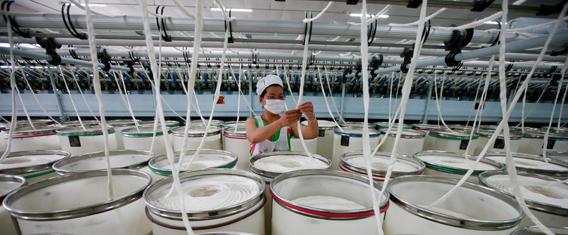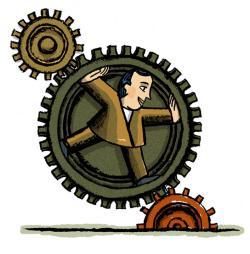When I began to gather information for this Slate series on operations management, I asked a few business-school professors to recommend books I might read on the topic. I expected I’d be pointed toward textbooks and manuals—perhaps written by the professors themselves, or by celebrity CEOs. Instead, I was urged to read a novel by a dead Israeli physicist.
The Goal narrates the story of Alex Rogo, a fictional plant manager in a fictional small town. Alex’s factory is floundering—shipping orders late, losing money—and his marriage is deteriorating under the stress. His division manager has given him three months to turn the plant around before it’s closed and all his employees are laid off. Meanwhile, his wife has moved in with her parents, leaving two kids behind. The future looks bleak. Until Alex, killing time before a flight in an airport lounge, runs into Jonah—his former college physics professor, who is now a globe-hopping corporate consultant.
Jonah employs the Socratic method to walk Alex through a series of ideas about how to fix his factory. Jonah has all the answers, and everything he suggests succeeds beyond Alex’s wildest dreams. With his hard-science background, his yarmulke, and his cigar habit, Jonah is a barely-disguised stand-in for the book’s author: Eli Goldratt, the Israeli management guru who wrote The Goal back in 1984. If you watch a few YouTube clips of Goldratt (who died in 2011), it’s easy to envision him similarly hypnotizing a mentee with the slow, assured rhythms of his speech.
In the novel, Goldratt lays out what he terms a “theory of constraints.” The idea is that the success of an entire factory (or, in fact, of any process at all) is determined by the choke point that constrains the overall output. In other words, the whole factory can only move as fast as its slowest element. This bottleneck could occur at the beginning of the process, the middle, or the end. It could be an outdated machine, an incompetent worker, or a stupid company-wide regulation. But whatever the bottleneck is, every action should be taken with it in mind, and every resource should be directed at eliminating it. Once the worst bottleneck is identified and vaporized, you go hunting for the next worst, and then the next.
This may sound intuitive—a chain is only as strong as its weakest link. But Goldratt paints a dismayingly believable portrait of a company resisting common sense. For instance, when Alex pulls workers off other machines to make sure the bottleneck machine is never idle, the floor manager frets that the nonbottleneck machines are no longer operating at peak efficiency (even though they’d been spitting out a stream of parts that would stack up uselessly, awaiting the output of the bottleneck machine before the final product could be fully assembled). When Alex asks workers to rearrange their breaks around the schedule of the bottleneck machine, the union rep squawks that this isn’t in the labor agreement. And the old accounting methods initially fail to capture the value of Alex’s breakthroughs, leading higher-ups to draw the wrong conclusions.
Amazingly, for a book about operations management in a fake manufacturing plant, The Goal is a page turner. We get caught up in Alex’s struggle, and can’t resist reasoning along with him as he puzzles out Jonah’s gnomic advice. The eureka moment comes not in a conference room, but on a hiking trail, as Alex leads his son’s scout troop on an overnight trip. Alex notices that the single-file line of scouts never manages to maintain consistent spacing. Instead it always spreads out, with the speedy kid at the front zooming out of sight. I found myself shouting in my living room, “The fat kid is the bottleneck! The fat kid is the bottleneck!” And indeed, once Alex realizes this, he sees that the group as a whole can only move as fast as poor little Herbie, the chubby scout who’s clogging things up in the middle of the line.
Sure, the quick scout at the front might get to the campsite in a jiffy, but the pack as a whole hasn’t met its goal until all the scouts have safely arrived (just as a factory hasn’t met its goal until the product is fully assembled—no matter how fast individual components might zoom through the assembly line). So Alex puts porky Herbie at the front of the line and distributes everything in Herbie’s backpack to the other kids, lightening his load. The faster kids behind have no problem keeping up with leader Herbie, which means they won’t pant and run out of steam while hustling to maintain the pace.

Photograph by STR/AFP/GettyImages.
There’s pleasure in rooting for Alex to save the plant and his marriage, in watching him succeed, and in solving these operations puzzles yourself. You feel smarter when you’ve finished the book. Which makes it worth wading through the middling (though unobtrusive) prose and dialogue like this:
Thinking, she sips her coffee for a moment. Her brow compresses in concentration. Then she says, “If we cut our batch sizes in half, then I guess that at any one time we’d have half the work-in-process on the floor.”
Or this:
I nod, understanding now. “So you could do more parts, even though it took you longer per part. Then why did we buy the NCX-10?”
“Each of the other machines had to have a machinist to run it,” says Bob. “The NCX-10 only needs two guys on it for setups. Like I said, it’s the lowest cost way for us to produce these parts.”
My 20th-anniversary edition of The Goal claims that, by 2004, the book had sold 3 million copies, been translated into 21 languages, and been taught in more than 200 colleges and universities. It’s easy to see why. Any newly promoted plant manager or aspiring MBA would benefit from the book’s ability to clearly and (relatively) painlessly explain the roots of operational efficiency. The back of the anniversary edition features testimonials from managers at major organizations, including one at General Motors who describes a specific bottleneck: The person installing the fuzzy, felt ceilings of cars had to drag the felt some distance to the assembly line, slowing the entire operation down. The factory floor was reconfigured so the felt rolls were kept closer by. Sounds obvious. But this sort of simple inefficiency can go unnoticed at even the biggest companies, and can have surprisingly outsize effects on the bottom line.
If, like me, you majored in liberal arts and never expect to run a factory, The Goal still provides a fascinating look inside a world that may have previously been opaque. You watch through Alex’s eyes as he struggles to deal with his workers, the union rep, the accountant, the materials procurer, and the fat cats at corporate headquarters. Once you’re done reading, you’ll feel as though you might just be able to step in and operate a plant yourself. And you’ll never look at those big, square buildings you drive past on the highway access road in quite the same way. It’s easy to forget there are real people inside them, trying to make their jobs and their companies—and, not incidentally, their lives—run more smoothly.
